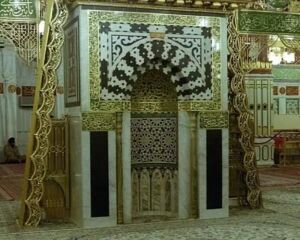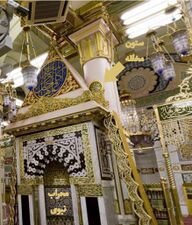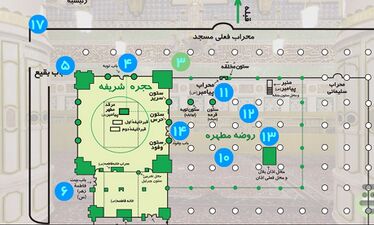The Prophet's Mihrab
 | |
| General Information | |
|---|---|
| Other Names | Mihrab al-Nabi, Mihrab Rasulallah |
| Place | Masjid al-Nabi |
| History | |
| Reconstructions | In the time of Umar b. Abdul Aziz and Mamalik of Egypt |
| Reconstructors | Qaytbay |
Mihrab of the Prophet (s) (Arabic: محراب النبي) is the place where Prophet Muhammad(a) used to pray, which is located in the al-Masjid al-Nabawi between the Prophet's pulpit and his grave. During the time of the Prophet (s), there was nothing in the form of a mihrab, until later during the development of the al-Masjid al-Nabawi during the period of al-Walid b. 'Abd al-Malik, a mihrab was built in the place of his prayer. Qaitbay, the king of Egypt (9th/15th century) rebuilt the hollow-shaped mihrab by renewing the mosque. this mihrab was decorated during the era of Ottoman rule and is still located in al-Masjid al-Nabawi.
History
During the time of Prophet Muhammad(a), in the place of al-Masjid al-Nabaw where he prayed, there was no mihrab in any form[1] and the place of prayer of the Prophet (s), had no sign except that it was next to the al-Mukhallaqa pillar.[2] This was the first time in the development of al-Masjid al-Nabawi, during the period of al-Walid b. 'Abd al-Malik (r. 86/705 -96/714-5), that a mihrab was built at the place of the Prophet's prayer.[3]
During the Mamluk Period
Although historical sources do not have any reports about the reconstruction of the mihrab during the period of Baybars al-Bunduqdari (r. 658/1259-60 - 676/1277-8), the fourth Mamaluk king, some researchers, by examining historical evidence, believe that the first hollow-shaped mihrab (carved into the wall) in the reconstructions of the Baybars period was made in the place that Prophet Muhammad(a) prayed; Because the reports of the sources before this date did not mention the existence of a hollow-shaped mihrab in the place of the Prophet's prayer.[4] In the reconstruction of al-Masjid al-Nabawi during the period of Qaitbay, the Mamluk sultan, in 888/1483-4 after the fire in al-Masjid al-Nabawi, the mihrab was rebuilt in the place of the Prophet's prayer, and in the same period, it was decorated with marble and verses from the Quran were engraved on it.[5]
In the Ottoman Period
In the reconstruction of al-Masjid al-Nabawi during the reign of king Abdul-Majid I, the mihrab of the Prophet, which was left over from the time of Qaitbay, was gilded. Also, during this time, ʿAbd Allah al-Zuhdi, a Turkish calligrapher, engraved verses of the Quran, texts and poems on the mihrab.[6] In the Saudi period, the same mihrab of the Qaitbay period remained.[7]
Location
The Prophet's mihrab was built in the place of al-Masjid al-Nabawi where Prophet Muhammad(s) prayed.[8] This mihrab is located next to the al-Mukhallaqa pillar[9] and in the distance between the pulpit of the Prophet (a) and his grave (al-Rawḍa al-Sharifa).[10] Researchers are of the opinion that this place is the place where the Prophet(s) prayed. [11]
The mihrab is placed in such a way that the one who prostrates in it places his forehead on the Prophet's sitting place, not his prostration place. [12] The Prophet's prostration place is placed under the mihrab.[13]
Gallery
-
The mihrab of the Prophet(s) is connected to the al-Mukhallaqa pillar.
-
The location of the mihrab of the Prophet(s) on the map of al-Masjid al-Nabawi.
-
Decorations of the mihrab of the Prophet(s) with marble and gilding and verses from the Quran are written on it.
Notes
- ↑ Ṣāliḥ Lumaʿī, al-Madīnat al-munawwara, P. 59.
- ↑ ʿAṭṭār, ‘’Al-Taʿrīf bi tārīkh wa maʿālim al-masjid al-nabawī al-sharīf’’, p. 162.
- ↑ Sayyid al-Wakil, Al-masjid al-nabawii ʿabar tarikh, p. 128; Jaʿfariyan, athar-i islami-yi Makka wa Madina, p. 260.
- ↑ al-Shahri, ʿImara al-masjid al-nabawii, p. 227.
- ↑ al-Shahri, ʿImara al-masjid al-nabawii, P. 342.
- ↑ Ṣāliḥ Lumaʿī, al-Madīnat al-munawwara, p. 96.
- ↑ Ansari, ʿImarah wa tawsiah al-masjid al-nabawii, p. 170.
- ↑ Sayyid al-Wakil, Al-masjid al-nabawii ʿabar tarikh, p. 128; Jaʿfariyan, athar-i islami-yi Makka wa Madina, p. 260.
- ↑ Sayyid al-Wakil, Al-masjid al-nabawii ʿabar tarikh,p. 163.
- ↑ Sayyid al-Wakil, Al-masjid al-nabawii ʿabar tarikh,p. 163.
- ↑ Sayyid al-Wakil, Al-masjid al-nabawii ʿabar tarikh, p. 128; Jaʿfariyan, athar-i islami-yi Makka wa Madina, p. 260.
- ↑ Sayyid al-Wakil, Al-masjid al-nabawii ʿabar tarikh,p. 163.
- ↑ ʿAṭṭār, ‘’Al-Taʿrīf bi tārīkh wa maʿālim al-masjid al-nabawī al-sharīf’’, p. 164.
References
- Ansari, Naji Muhammad hasan ʿabdu l-qadir al-. ʿImarah wa tawsiah al-masjid al-nabawii al-sharif ʿabar tarikh. [n.p], Nadi l-madina al-munawwara al-adabi, 1996.
- Hazzaʿ al-Shahri, Muhammad .ʿImarah al-masjid al-nabawii munzu inshaʾihi hatta nihaya al-ʿasr al-mamlūki. Cairo: Cairo: Maktabat al-qahira li-l kutub, 2001.
- Hazzaʿ al-Shahri, Muhammad .Al-masjid al-nabawii al-sharif fi al-ʿasr al-ʿuthmani. . Cairo: Dar al- qahira, 2003.
- Jaʿfariyan, Rasūl. ‘’athar-i islami-yi Makka wa Madina’’. Tehran: Mashʿar, 1391 Sh
- Ṣāliḥ Lumaʿī, Muṣṭafā. ‘’Al-Madīnat al-munawwara, taṭawwurihā l-ʿumrānī wa turāthihā l-miʿmārī’’. Beirut: Dār al-Nihḍa al-ʿArabīyya, 1981.
- Sayyid al-Wakil, Muhammad al- .Al-masjid al-nabawii ʿabar tarikh. [n.p], Dar al-mujtamaʿ li-lnashr wa al-tawziʿ, 1988.
- Sayyid Ḍiyaʾ b. Muhammad b. Maqbūl ʿAṭṭar.Al-Taʿrif bi tarikh wa maʿalim al-masjid al-nabawii al-sharif. Jeddah: Kunūz al-maʿrifa, 1432 AH.


